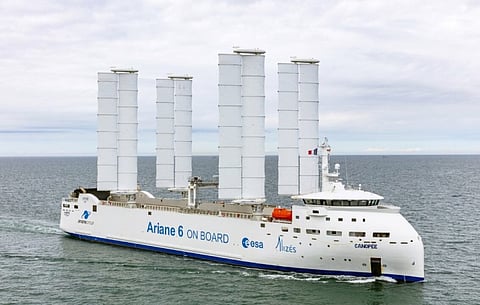

Netherlands-based shipbuilder Neptune Marine has delivered a new hybrid-powered, open-top Ro-Ro vessel to French shipping company Jifmar Offshore Services.
The 121- by 22-metre, 5,400DWT Canopée was developed to satisfy a series of complex requirements. The ship needed to possess ample deck area and must be able to sail quickly. The vessel also needed to be able to sail at a limited draught of only 4.3 metres, and the permitted transverse, longitudinal, and vertical accelerations must not exceed the set criteria.
The most visible key feature are the four Ayro 30-metre-tall, articulated wind-assist sailing units. These create a propulsion force to reduce fuel consumption by as much as 30 per cent, which will in turn reduce CO2, NOx, and SOx emissions. Use of the sailing units will also help ensure a CO2 reduction of as much as 7,200 tonnes each year.
The sailing units will serve only as the ship's auxiliary propulsion as the primary propulsive power will be provided by two 3,480kW engines driving controllable-pitch propellers. The main engines can run on either diesel or LNG and will enable the ship to reach a service speed of 16.5 knots. A Hoppe Marine anti-heeling system automatically activates by transferring ballast while a stabilisation system consists of anti-roll keels that operate in conjunction with the damping of the ballast water tanks.
Cargo can be carried on a 94- by 17.6-metre space on the main deck, in a 45- by 14.4-metre space in the lower hold, and in a 21.6- by 12-metre space on a removable mezzanine deck. Ro-Ro cargo is loaded and unloaded via a stern ramp. Also fitted are a 60-tonne gantry crane on the main deck and a smaller provision crane on the port side.
The ship is also fitted with 19 cabins for housing the 11 crewmembers and up to 11 additional personnel. The other accommodation spaces include two mess areas, two day rooms, a gym, a bridge conference area, a hospital, and a ship's office. Electrical power for the onboard systems is supplied by two Scania DI13 generators each rated at 300 kW.
Canopée will be operated by Alizes, a joint venture formed by Jifmar and French freight specialist Zéphyr and Borée, on behalf of customer ArianeGroup. It will be used exclusively for the transport of components of the Ariane 6 expendable launch vehicle from manufacturing facilities in Europe to the assembly site in Kourou in French Guyana in time for the vehicle's inaugural launch in 2024.
| Canopée | |
| SPECIFICATIONS | |
| Type of vessel: | Ro-Ro vessel |
| Classification: | I ✠ HULL ✠ MACH Ro-Ro cargo ship – unrestricted navigation ✠ AUT-UMS , MON-SHAFT, Comf. Noise 3, Comf. vib. 3. |
| Flag: | France |
| Owner: | Jifmar Offshore Services, France |
| Operator: | Alizes, France |
| Builder: | Neptune Marine, Netherlands |
| Length overall: | 121 metres |
| Beam: | 22 metres |
| Draught: | 4.3 metres |
| Deadweight tonnage: | 5,400 |
| Gross tonnage: | 10,669 |
| Net tonnage: | 3,200 |
| Main engines: | 2 x 3,480 kW |
| Propulsion: | 2 x controllable-pitch propellers; 4 x Ayro sailing units |
| Generators: | 2 x Scania DI13, each 300 kW |
| Side thrusters: | 2 x 450 kW |
| Cruising speed: | 16.5 knots |
| Cranes: | 2 |
| Other equipment installed: | Hoppe Marine anti-heeling system |
| Types of fuel: | Diesel; LNG |
| Accommodation: | Cabins; 2 x mess areas; 2 x day rooms; gym; bridge conference area; hospital; ship's office |
| Crew: | 11 |
| Passengers: | 11 |
